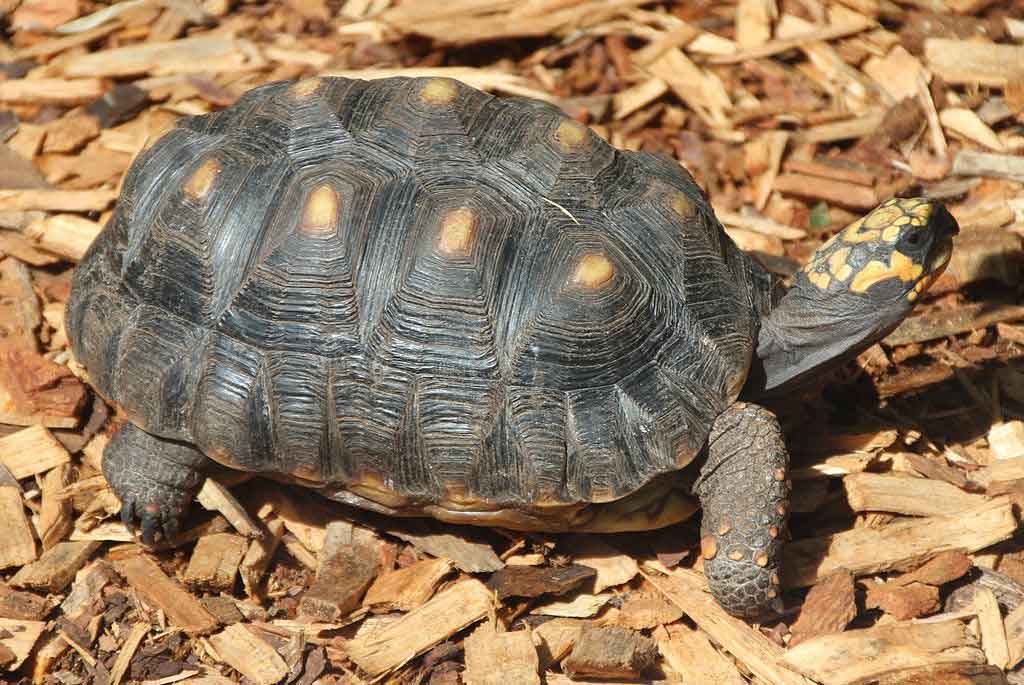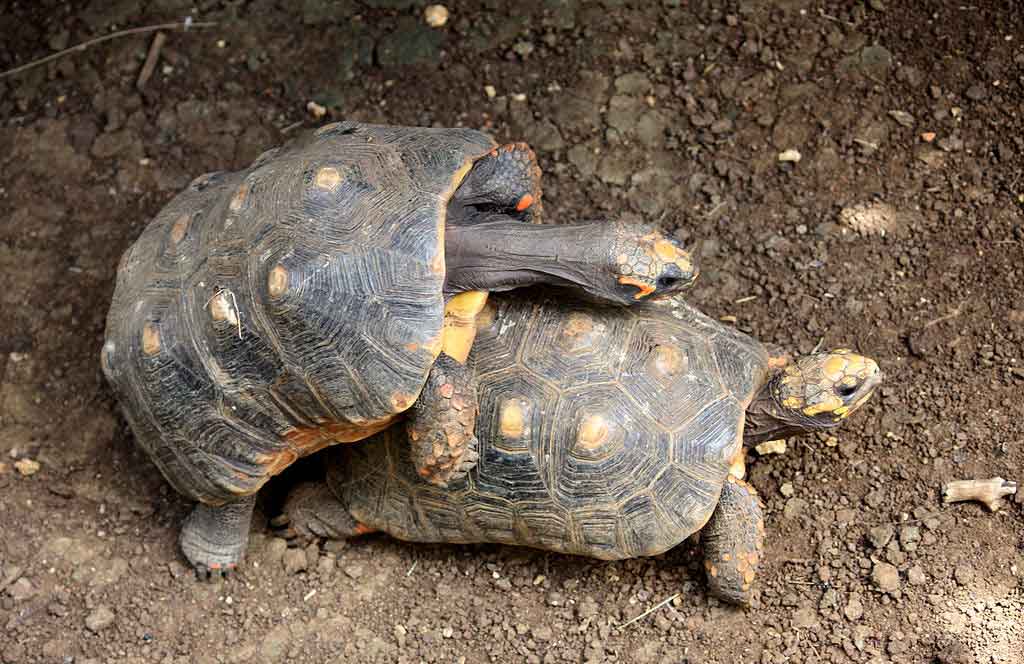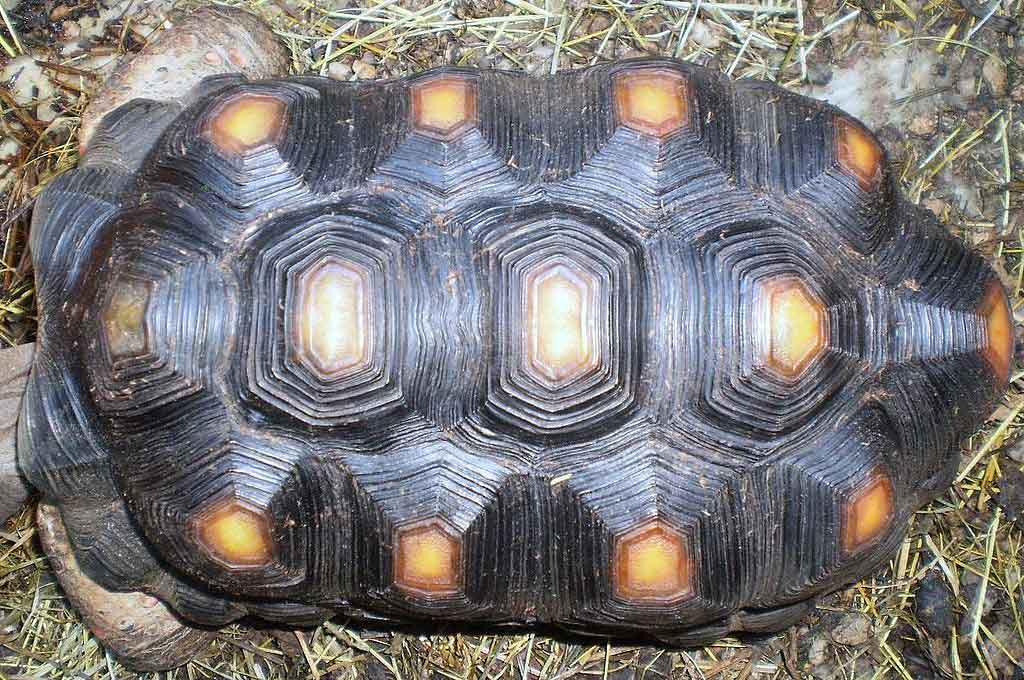
Content |
|---|
Origin
The home of the Red-footed tortoise (Chelonoidis carbonaria) is tropical South America, where its distribution is divided into a northern and a southern zone. In the north it is located between Panama and northern Brazil, in the south from southern Brazil through Peru, Bolivia and Paraguay to Argentina. It is represented from tropical to subtropical in the south to the degree 25 latitude. There is a regular alternation between hot summers and dry winters..
Characteristics / Appearance
With a dorsal shell of 50 centimeters, the Red-footed tortoise is a medium-sized specimen. As an adult in captivity, usually weighs more than 20 kg. It is especially striking for its black background color, that marks the head, the neck and shell of the animal. The legs of the turtle have spots between red and orange, similar to those of the neck and head. The color is extremely atypical for turtles and is the reason why the animal is also called “red-footed turtle”.
With its high shell, the Red-footed tortoise it is also very well protected against falls on its back and can quickly help itself to its feet in the event of such a fall. The black shields of the dorsal shell are always yellow in the center. As it usually lives in humid areas, the turtle needs long legs to be able to walk easily through swampy areas.
Habitat
The Red-footed tortoise is native to the rainforest, but also of the savannahs. In this wide range, turtles differ quite a bit in size and coloration. In Argentina live populations with specimens that only reach a few 20 cm of shell length. On the other hand, the largest individuals are known in Brazil.
Behavior
Very little is known about the way of life in nature. The Red-footed tortoise lives in dry lowlands, grasslands and adjacent forest regions. Sometimes, these tortoises are also found in open areas of humid forests. The diet is largely made up of plant foods, but also carrion.
Reproduction
The breeding season begins with the start of the rainy season. The female lays from 6 to 10 eggs in a nest dug by herself that only has a few 10 depth cm. The incubation period depends on the ambient temperature and humidity and ranges from 100 and 150 days.
The courtship is ritualized: Males surround females willing to reproduce, biting them repeatedly on the legs. The cloacal region of the female is intensely touched. Finally, the male positions himself frontally in front of the female and rocks his head back and forth before mating.
Threats to the species
State of conservation ⓘ |
||
|---|---|---|
 Vulnerable ⓘ
(UICN)ⓘ
Vulnerable ⓘ
(UICN)ⓘ
| ||
The Red-footed tortoise is considered to be vulnerable and is included in the Appendix II of the CITES, which restricts international trade, although this does not offer protection within a country and smuggling continues to occur in large quantities. Conservation parks and refuges, captive breeding farms in natural conditions and the rise of captive breeding in other countries have helped, but they are still exported in large quantities (35.565 between 2000 and 2005), especially as pets and food. Registered exports do not include smuggling or other losses, which some estimate at more than double that figure. They are considered especially threatened in Argentina and Colombia, and are considered more threatened than the Yellow-footed tortoise (Chelonoidis denticulata) and Chaco tortoise (Chelonoidis chilensis).
They are widely used as food throughout their range, especially where other meats are limited. Their ability to go a long time without eating makes it easy to catch and keeps them fresh for long periods. The Catholic Church allows eating turtles on fast days when most meats are prohibited., like Lent. Turtle cake (served on a turtle shell) It is one of the favorite foods for those days, and large quantities of turtles are exported for that purpose only. Even people who live in countries with abundant livestock available enjoy wild game, like turtles, where possible. Hunting for food is so widespread that Colombia and some other countries import turtles from their neighbors..
The habitat destruction is another major threat to the Red-footed tortoise, and for so many other species. They are also widely collected as local pets and their shells are sold as souvenirs..
The "Red-footed tortoise" in captivity
Keeping
The Red-footed tortoise it can only be maintained adequately to the species in private tenure with a lot of effort. The animal needs a high tropical humidity and at the same time a very high temperature. An ambient temperature of 28 to 32 °C. The temperatures of 40 °C should prevail under various technically constructed basking zones (consisting of HQI lamps). The Red-footed tortoise you need these conditions. It also, the animal must constantly have fresh water for bathing and drinking. Since these turtles like to bathe and often get into the water, small bowls and bowls are not enough. You have to offer real bathroom facilities. Preferably with a drain to maintain hygiene.
Young and semi-sweet animals must have 20 to 30 square meters of outdoor enclosure with an annexed barn or greenhouse. The Red-footed tortoise adult must have at least 50 square meters of outdoor space. For a breeding appropriate to the species, it is recommended to plan from 100 square meters. Animals are extremely active and move around a lot every day. They also differ in the way they face the sun. While our European turtles and many other tropical turtles like direct sun, the Red-footed tortoise needs much shaded areas to protect from direct sun.
Reproduction
In the wild, breeding begins with the rainy season (in Europe, from May to August) and follows a clear ritual. The male of the Red-footed tortoise surrounds the female and attracts her attention by constantly biting her legs. The male's nose is always in the female's cloaca. As soon as the female no longer flees, the male climbs on top of it and turns his head to the right and left before mating begins..
Keeping turtles in captivity ensures that they can lay eggs virtually all year round. One to two clutches of eggs are produced per year. There are 4 to 10 eggs in each clutch. The female lays the eggs in a pit of up to 20 depth cm, that she herself chooses in a humid and warm place in the outdoor area. In the days before the eggs are laid, the female can often be seen doing some test excavations.
If you want to incubate the eggs and look for young, you need to carefully pick them up after laying and transfer them to an incubator. At a constant substrate temperature of 33 °C, The young will hatch after 110 to 130 days. It is important to maintain the 100% humidity in the incubator and use a very moist substrate. The temperature in the incubator is usually slightly higher than that of the substrate. High fluctuations should be avoided.
Buy one "Red-footed tortoise"
The price of a "Red-footed tortoise" at the exotic animal market, bred in captivity, ranges between 200 – 700 EUR, depending on its shell and size.
Images "Red-footed tortoise"
 |
 |
 |
 |
|
Red-footed Tortoise (Chelonoidis carbonarius)
Apure, The LLanos, VENEZUELA
|
Red-footed tortoise |
Mating of red-footed turtles (Chelonoidis carbonarius). In captivity in the Barbados Wildlife Reserve. - Postdlf, CC BY-SA 3.0, via Wikimedia Commons |
Red-footed turtle karapax - via Wikimedia Commons |
Videos "Red-footed tortoise"
|
|
|
|---|
Alternative names:
1. Chelonoidis carbonarius (English).
2. Tortue charbonnière (French).
3. Morrocoy Schildkröte (German).
4. Jabuti, Jabuti-do-cerrado, Jabuti-Vermelho (Portuguese).
5. Tortuga de patas rojas, Morrocoy Sabanero, Morrocoy, Karumbe (español).
